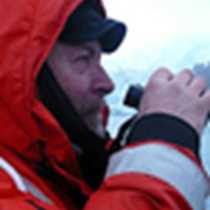At Sea & South Shetland Islands
Today was the day we were introduced to Antarctica, although the process began yesterday. We watched the temperature of the sea water drop as we approached the convergence, the boundary of the biological Antarctic. Early this morning we crossed 60º south latitude, which marks the geographic border to Antarctica. Fog and drizzle are with us this morning but someone spots a blow from a whale and we all dash to the decks or the windows of the library. Three blows and then two more, making five in all. Which species are these?
The key elements of the animal begin to reveal themselves. The dorsal fin is falcate in shape, the body long and dark. We have our suspicions and then the telltale sign appears; the right side of the lower jaw is white - they are fin whales. The second largest of all whales, these 50+ ton baleen cetaceans come south in summer to gorge themselves on the krill that drive the food chain of all Antarctica. For some time we cruise along together, the whales surfacing and blowing on the port bow while we stand in awe on the decks.
As we approach the South Shetlands, penguins usher us along, porpoising ahead of the ship. The poor visibility keeps Elephant Island hidden from view as afternoon progresses but inevitably, we sight land. It is dramatic and moody. Glaciers shrouded in gray pour down from steep mountain faces. Brash ice surges in the shallows as the sea breaks its back on the shore. The rain alternates with snow while the thermometer hovers at freezing. This is our first look at Antarctica and we are eager to get into the Zodiacs for a short cruise and closer views. Chinstrap penguins are everywhere and their raucous calls fill the air while the aroma of guano confirms our arrival to the seventh continent.
Our cruise takes us around Point Wild and to the scant shingle beach where 22 men waited through the southern winter of 1916 for rescue. Living under upturned boats, these men’s hopes were kept alive and their spirits high by Frank Wild until Ernest Shackleton returned to pluck them to safety. Looking at the old photographs of the camp we can easily recognize the land forms and the coast.
For students of Antarctic exploration and Shackleton buffs, this is hallowed ground. The thread of history connects us today. Eight thousand miles away the nation’s capitol is immersed in the presidential inauguration. In the lounge of the National Geographic Endeavour, through the magic of satellite, we hear our new leader’s address to the world. As the speech concludes we get our first views of Antarctica and complete our day by cruising the shore where 93 years ago, unable to contact the outside world, brave men waited for their leader to bring them home.
Today was the day we were introduced to Antarctica, although the process began yesterday. We watched the temperature of the sea water drop as we approached the convergence, the boundary of the biological Antarctic. Early this morning we crossed 60º south latitude, which marks the geographic border to Antarctica. Fog and drizzle are with us this morning but someone spots a blow from a whale and we all dash to the decks or the windows of the library. Three blows and then two more, making five in all. Which species are these?
The key elements of the animal begin to reveal themselves. The dorsal fin is falcate in shape, the body long and dark. We have our suspicions and then the telltale sign appears; the right side of the lower jaw is white - they are fin whales. The second largest of all whales, these 50+ ton baleen cetaceans come south in summer to gorge themselves on the krill that drive the food chain of all Antarctica. For some time we cruise along together, the whales surfacing and blowing on the port bow while we stand in awe on the decks.
As we approach the South Shetlands, penguins usher us along, porpoising ahead of the ship. The poor visibility keeps Elephant Island hidden from view as afternoon progresses but inevitably, we sight land. It is dramatic and moody. Glaciers shrouded in gray pour down from steep mountain faces. Brash ice surges in the shallows as the sea breaks its back on the shore. The rain alternates with snow while the thermometer hovers at freezing. This is our first look at Antarctica and we are eager to get into the Zodiacs for a short cruise and closer views. Chinstrap penguins are everywhere and their raucous calls fill the air while the aroma of guano confirms our arrival to the seventh continent.
Our cruise takes us around Point Wild and to the scant shingle beach where 22 men waited through the southern winter of 1916 for rescue. Living under upturned boats, these men’s hopes were kept alive and their spirits high by Frank Wild until Ernest Shackleton returned to pluck them to safety. Looking at the old photographs of the camp we can easily recognize the land forms and the coast.
For students of Antarctic exploration and Shackleton buffs, this is hallowed ground. The thread of history connects us today. Eight thousand miles away the nation’s capitol is immersed in the presidential inauguration. In the lounge of the National Geographic Endeavour, through the magic of satellite, we hear our new leader’s address to the world. As the speech concludes we get our first views of Antarctica and complete our day by cruising the shore where 93 years ago, unable to contact the outside world, brave men waited for their leader to bring them home.




